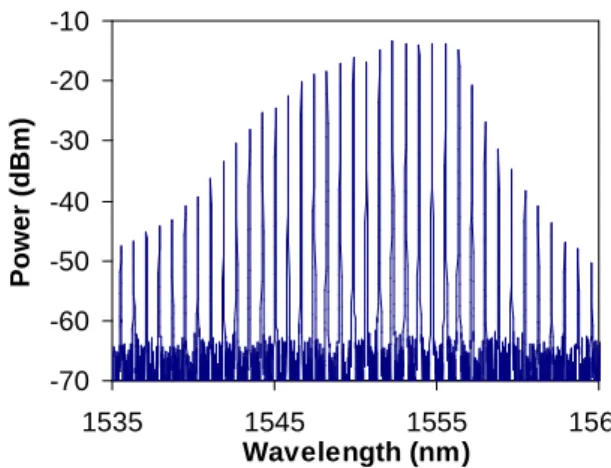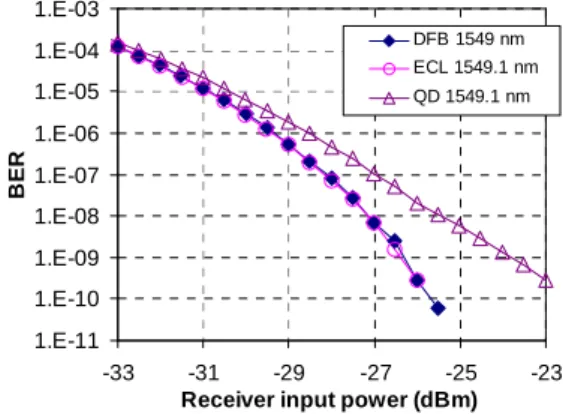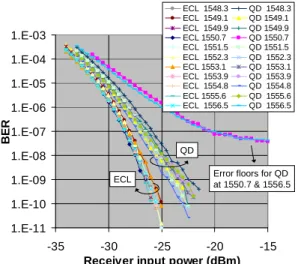HAL Id: hal-00569382
https://hal.archives-ouvertes.fr/hal-00569382
Submitted on 24 Feb 2011
HAL is a multi-disciplinary open access
archive for the deposit and dissemination of
sci-entific research documents, whether they are
pub-lished or not. The documents may come from
teaching and research institutions in France or
abroad, or from public or private research centers.
L’archive ouverte pluridisciplinaire HAL, est
destinée au dépôt et à la diffusion de documents
scientifiques de niveau recherche, publiés ou non,
émanant des établissements d’enseignement et de
recherche français ou étrangers, des laboratoires
publics ou privés.
Quantum-dash mode-locked laser source for
wavelength-tunable 56 Gbit/s DQPSK
Yousra Ben M’Sallem, Quang Trung Le, Laurent Bramerie, Quoc Thai
Nguyen, Eric Borgne, Pascal Besnard, Sophie La Rochelle, Leslie A. Rusch,
Jean-Claude Simon
To cite this version:
Yousra Ben M’Sallem, Quang Trung Le, Laurent Bramerie, Quoc Thai Nguyen, Eric Borgne, et
al.. Quantum-dash mode-locked laser source for wavelength-tunable 56 Gbit/s DQPSK. 36th
Eu-ropean Conference on Optical Communication (ECOC 2010), Sep 2010, Turin, Italy. pp.Mo.1.F.4,
�10.1109/ECOC.2010.5621590�. �hal-00569382�
Quantum-Dash Mode-Locked Laser Source for
Wavelength-Tunable 56 Gbit/s DQPSK
Yousra Ben M’Sallem(1,2), Quang Trung Le(1), Laurent Bramerie(1), Quoc-Thai Nguyen(1), Eric Borgne(1), Pascal Besnard(1), Sophie LaRochelle(2), Leslie A. Rusch(2), Jean-Claude Simon(1)
(1)
Université Européenne de Bretagne (UEB), CNRS-Foton laboratory (UMR 6082)/Université de Rennes 1, Enssat, BP 80518, 22305 Lannion Cedex, France, quang-trung.le@enssat.fr
(2)
Université Laval, ECE Dept., COPL, Québec, Canada, rusch@gel.ulaval.ca
Abstract We investigate wavelength tunable 56 Gbit/s DQPSK systems using comb generation in a
quantum-dash mode-locked laser. Relative intensity noise and bit error rate is measured for each mode. Error-free operation is obtained over 9 WDM channels with 100 GHz spacing.
Introduction
Since the phenomenal traffic growth of the Internet, data traffic has rapidly overtaken voice as the dominant information type transported by today’s high speed communication networks. The next generation of optical networks requires efficient densely packed WDM channels to transmit massive amounts of information. An important challenge is the cost and the wave-length versatility of WDM transmitters.
WDM transmission using comb generation in a mode-locked laser (MLL) has been proposed as a cost-effective solution. The multiple fre-quencies (modes) of the MLLs offer several advantages compared to sets of single mode distributed feedback (DFB) lasers: fixed channel spacing set by the MLL mode spacing, reduced channel crosstalk due to the coherence of the MLL modes, etc.1 In addition, no individual channel frequency control is needed.
Optical frequency combs have been demon-strated using different configurations based on mode locked lasers. Examples include ampli-tude or frequency modulated mode-locked lasers, e.g., Er:Yb:glass laser oscillators2, fibre ring lasers3 or mode-locked semiconductor lasers4. Semiconductor lasers consume signifi-cantly less power as no pump diode laser is required. Recently, semiconductor quantum-dot or quantum-dash mode-locked lasers have been heavily investigated owing to remarkable proper-ties, including low-noise, high thermal stability, and a broad gain spectrum5. They have been examined as particularly attractive sources for wavelength division multiplexing (WDM) using on-off keying (OOK)6.
Phase-shift keying (PSK) has recently emerged as an alternative to conventional OOK modulation allowing for much higher spectral efficiencies. Despite their relatively complex transmitter and receiver setups, PSK is a strong candidate for high data-rate and spectrally efficient DWDM systems7. In this paper, we
demonstrate for the first time that a quantum-dash mode-locked laser (QD-MLL) can be used as multi-wavelength laser for 56 Gbit/s DQPSK transmission. We demonstrate that relative intensity noise (RIN) and phase noise over all modes are compatible with PSK modulation. We quantify DQPSK performance via bit error rate (BER) measurements and compare perform-ance to that of an external cavity laser (ECL) source.
QD-MLL characterisation
The laser is fabricated with an active core con-sisting of 6 InAs-based QD layers. A cavity length of 420 µm yields a mode spacing of 100 GHz; the device structure was reported in [6]. The optical spectrum of the laser is given in Fig. 1. Due to mode-locking, a wide spectrum is observed. The 3 dB optical bandwidth is about 8 nm, covering ten optical modes.
Fig. 2 shows the RIN measurement results of 1) a commercial ECL, 2) all QD-MLL modes taken together, and 3) each filtered QD-MLL mode (from 1548.3 nm to 1555.6 nm). Gener-ally, the QD lasers have low intensity noise thanks to low amplified spontaneous emission (ASE)5. The RIN of the total of all modes is even lower than that of a commercial ECL. However,
-70 -60 -50 -40 -30 -20 -10 1535 1545 1555 1565 Wavelength (nm) Po w e r (d B m )
Fig. 1: Optical spectrum of the QD-MLL. ECOC 2010, 19-23 September, 2010, Torino, Italy
978-1-4244-8535-2/10/$26.00 ©2010 IEEE
when using a QD-MLL wavelength comb as a WDM source, the RIN increases for each filtered mode due to mode partition noise8. As shown in Fig. 2, the RIN floor of one filtered mode can be as high as -100 dBc/Hz for frequencies below 500 MHz, decreasing to -130 dBc/Hz at 10 GHz for the worst case observed. RIN is much higher than that of a commercial ECL (see Fig. 2).
Fig. 3 summarizes the RIN (at 100 MHz) and power level of each QD-MLL mode examined. Not surprisingly, the RIN of the non-dominant modes are strong compared to the QD-MLL dominant modes. In the next section we assess the impact of this higher RIN level on BER performance for DQPSK.
Experimental setup
The experimental setup (Fig. 4) consists of a 56 Gbit/s DQPSK transmitter and receiver. A 100 GHz quantum-dash Fabry-Perot mode-locked laser source is used at the transmitter. The output of the laser passes through an optical isolator and then an arrayed waveguide grating (AWG) wavelength demultiplexer (for this experiment we use a tunable filter).
The selected lasing mode is amplified using an EDFA and externally modulated using a DQPSK, LiNbO3 Mach-Zehnder interferometer (MZI). With the test equipment available, we generate two 29-1 pseudo random binary se-quences (PRBS) delayed by 256 bits to decorre-late them. At the receiver the signal is pre-amplified, filtered and demodulated with delay interferometers (DLI). The DIs and balanced detectors convert the optical phase modulation into intensity modulation. The 28 Gbit/s bit stream passes through a 1:4 electronic demulti-plexing stage; the 7 Gbit/s streams are sent to the error detector. The experimental test bed was implemented on the Persyst platform at Foton laboratory.
Experimental results
Results of DQPSK back-to-back measurements are shown in Fig. 5. For reference, the curve with square markers indicates BER vs. receiver input power for a DFB; BER is 10-9 at -26 dBm. BER for an ECL source is reported with circle markers. Using one mode of the QD-MLL as a source yields BER reported with triangle
mark-1.E-11 1.E-10 1.E-09 1.E-08 1.E-07 1.E-06 1.E-05 1.E-04 1.E-03 -33 -31 -29 -27 -25 -23
Receiver input power (dBm)
B E R DFB 1549 nm ECL 1549.1 nm QD 1549.1 nm
Fig. 5: Bit error rate vs. receiver input power.
-150
-140
-130
-120
-110
-100
-90
10
100
1000
10000
Frequency (MHz)
R
IN
(
d
B
c/
H
z)
1548.3 1549.1 1549.9 1550.6 1551.5 1552.3 1553.1 1553.9 1554.8 1555.6 1556.5 ECL Total mode of QD-MLLFig. 2: Relative intensity noise (RIN).
-115 -110 -105 -100 -95 R IN ( d B c /H z ) -20 -15 -10 1547 1549 1551 1553 1555 1557 Wavelength (nm) P o w e r (d B m )
Fig. 3: Power level and RIN of each DQPSK
QD-MLL channel.
I
NRZ DQPSK transmitterQ
NRZ DQPSK balanced receiver QD laser Pre-Amp π/2+
Demux1:4+
Demux1:4 7 G b it/ s to B E R T PRx PRBS 28 Gbit/s PRBS 28 Gbit/s DLIQ
I
Fig. 4: Experimental setup.
ers. All sources were centred at 1549 nm. The ECL and DFB give nearly identical BER. The QD-MLL has a power penalty of 2.5 dB at 10-9 compared to the DFB and ECL, yet nonetheless is error-free (BER<10-9). This penalty is due to high RIN when filtering the QD-MLL to isolate one mode as discussed in the previous section.
The performance of our system is evaluated for each mode of the QD-MLL. For each wave-length, the DQPSK system is first optimised using the wavelength-adjustable ECL source. Next each mode of the QD-MLL is isolated in turn, and BER measurements are compared for ECL and QD-MLL, see Fig. 6. Results show that the DQPSK performance for the QD-MLL is as stable as the tuned ECL over the entire 8 nm range, from 1548.3 nm to 1556.4 nm, covering 11 WDM channels with 100 GHz spacing. The receiver sensitivity of the system using ECL
varies between -26 dBm and -26.5 dBm in this wavelength range. When the QD-MLL is used, error-free performance is obtained over nine channels. Error floors at BER of 4×10-8 occur with two channels (1550.7 nm and 1556.5 nm). This is to be expected given the RIN and power level of those modes.
Finally, Fig. 7 shows the power penalty (BER of 10-9) of DQPSK signals using each QD-MLL mode. Power penalty from 2 dB to 4 dB is obtained over nine WDM channels. For the weak modes, the power penalty rapidly in-creases. Not surprisingly, the fluctuations in non-dominant modes are strong compared to that of the dominant modes.
Conclusions
We proposed and experimentally demonstrated for the first time the feasibility of a cost-effective, multi- wavelength seeding source based on QD-MLL for high speed and spectral efficient WDM systems using DQPSK modulation at 56 Gbit/s. We reported error-free signal operation over nine WDM channels with 100 GHz spacing. Therefore, this strategy is viable solution for future high bit rate optical communications networks.
Acknowledgements
This work was supported by the French National projects TELDOT and PERSYST II and by Québec’s Regroupement Stratégique Centre for Advanced Systems and Technologies in Com-munications (SYTACom). The authors would like to thank A. Shen and G.-H. Duan from Alcatel-Thales III-V Lab for the laser fabrication, and P. Chanclou from Orange Lab for lending the RIN measurement equipment.
References
1 T. Healy, et al., Proc. ECOC’07,PD 1.9 (2007). 2 S.C. Zeller et al., Proc. CLEO’05, 221 (2005). 3 S. Yamashita et al., Phot. Tech. Lett., 10, 796 (1998).
4 A. Gubenko et al., Electron. Lett., 43, 1430 (2007).
5 F. Lelarge et al., J. Selected Topics in Quan. Elec., 13, 111 (2007).
6 A. Akrout et al., Proc. ECOC’08, Th3.D.4 (2008).
7 C. Xu, et al., Photon. Technol. Lett., 15, 617 (2003).
8 Petermann, Laser diode modulation and noise, Kluwer Academic Publishers (1991). 1.E-11 1.E-10 1.E-09 1.E-08 1.E-07 1.E-06 1.E-05 1.E-04 1.E-03 -35 -30 -25 -20 -15
Receiver input power (dBm)
B E R ECL 1548.3 QD 1548.3 ECL 1549.1 QD 1549.1 ECL 1549.9 QD 1549.9 ECL 1550.7 QD 1550.7 ECL 1551.5 QD 1551.5 ECL 1552.3 QD 1552.3 ECL 1553.1 QD 1553.1 ECL 1553.9 QD 1553.9 ECL 1554.8 QD 1554.8 ECL 1555.6 QD 1555.6 ECL 1556.5 QD 1556.5
Error floors for QD at 1550.7 & 1556.5 QD
ECL
Fig. 6: Bit error rate vs. receiver input power for
11 ECL and QD-MLL channels.
0 2 4 P e n a lt y ( d B ) -20 -15 -10 1547 1549 1551 1553 1555 1557 Wavelength (nm) P o we r (d B m ) Error floor Error floor
Fig. 7: Power level and penalty (BER=10-9) of each DQPSK QD-MLL channel.


